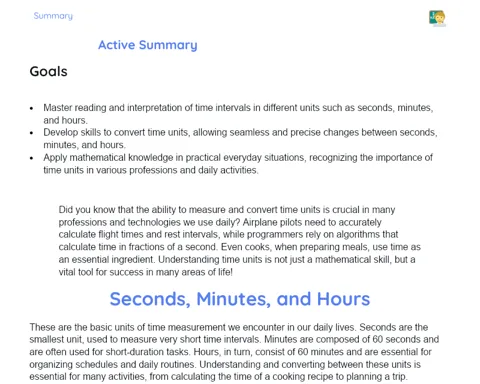Exploring Metric Relationships in Right Triangles: From Theory to Practice
Objectives
1. Understand the metric relationships in a right triangle derived from the similarity between triangles.
2. Correctly calculate the values of the legs, hypotenuse, and the height relative to the hypotenuse using the metric relationships.
Contextualization
Right triangles are fundamental in various fields of knowledge, from engineering to architecture. Understanding the metric relationships in these triangles is essential for solving practical problems, such as calculating the height of a building using shadows or determining the distance between two points that cannot be accessed directly. Additionally, these relationships form the basis for many principles of trigonometry, which have important applications in various scientific and technological disciplines. For example, engineers use these relationships to calculate forces and stresses in constructions, while information technology professionals apply them in computational graphics algorithms.
Relevance of the Theme
The importance of the topic in the current context is undeniable. With the growing demand for skilled professionals in technical and scientific fields, understanding metric relationships in right triangles becomes a valuable skill. These relationships are applied in various professions, such as engineering, architecture, and information technology, contributing to the development of innovative and efficient solutions for real-world problems. Mastering these concepts prepares students to face the challenges of the job market, making them more competitive and capable of solving everyday practical problems.
Definition and Properties of Right Triangles
A right triangle is a triangle that has a right angle (90 degrees). The properties of this type of triangle are fundamental in geometry and in various practical applications. The hypotenuse is the side opposite the right angle and is always the longest side of the triangle. The other two sides are called legs. The sum of the squares of the legs is equal to the square of the hypotenuse, a relationship known as the Pythagorean Theorem.
-
A right triangle has a right angle of 90 degrees.
-
The hypotenuse is the side opposite the right angle and is the longest.
-
The other two sides are called legs.
-
Pythagorean Theorem: the sum of the squares of the legs is equal to the square of the hypotenuse.
Similarity of Triangles in Right Triangles
The similarity of triangles occurs when two triangles have the same angles and their corresponding sides are proportional. In a right triangle, the similarity can be observed when drawing the height relative to the hypotenuse, dividing the original triangle into two smaller triangles that are similar to the original triangle and to each other. This property is crucial for deducing several metric relationships.
-
Triangle similarity: equal angles and corresponding sides proportional.
-
Drawing the height relative to the hypotenuse creates two triangles similar to the original triangle.
-
Essential property for deducing important metric relationships.
Metric Relationships in Right Triangles
The metric relationships in right triangles involve the measures of the sides and the height relative to the hypotenuse. For example, the height relative to the hypotenuse divides the hypotenuse into two segments, and each leg is the geometric mean between the hypotenuse and the segment of the hypotenuse adjacent to the leg. These relationships allow you to calculate any side or height knowing the other values.
-
Height relative to the hypotenuse divides the hypotenuse into two segments.
-
Each leg is the geometric mean between the hypotenuse and the adjacent segment.
-
Metric relationships allow calculating sides or heights knowing the other values.
Practical Applications
- Civil Engineering: Calculate the height of buildings using shadows and right triangles.
- Architecture: Determine the distance between architectural points that cannot be accessed directly.
- Information Technology: Use right triangles in rendering algorithms to create three-dimensional images.
Key Terms
-
Right Triangle: Triangle with a right angle.
-
Hypotenuse: Longest side of a right triangle, opposite the right angle.
-
Leg: One of the two shorter sides of a right triangle.
-
Pythagorean Theorem: Relationship stating that the sum of the squares of the legs is equal to the square of the hypotenuse.
-
Triangle Similarity: Condition in which two triangles have equal angles and proportional sides.
-
Metric Relationships: Relationships involving the measures of sides and heights in right triangles.
Questions
-
How can understanding the metric relationships in right triangles help in your future career?
-
What other everyday situations can you imagine where these concepts would be useful?
-
What challenges did you face while building the height meter and how did you overcome them?
Conclusion
To Reflect
Throughout this lesson, we explored the metric relationships in right triangles and their practical applications in various fields, such as engineering, architecture, and information technology. Understanding these relationships not only enriches our mathematical knowledge but also prepares us to solve real problems, making us more capable of facing challenges in the job market. Mathematics thus reveals itself as a powerful and versatile tool, essential for innovation and efficiency in different professions.
Mini Challenge - Practical Challenge: Measuring the Height of an Object
Use the metric relationships of right triangles to measure the height of a tall object in your home or school.
- Choose a tall object, such as a tree, light pole, or building.
- Build a simple device using cardboard, ruler, scissors, and tape as instructed in class.
- Position the device so that the ruler aligns with the shadow of the object.
- Measure the distance from the base of the triangle to the end of the shadow and record this measurement.
- Calculate the height of the object using the metric relationships of right triangles.
- Compare your results with those of your classmates and discuss possible sources of error and how to correct them.



